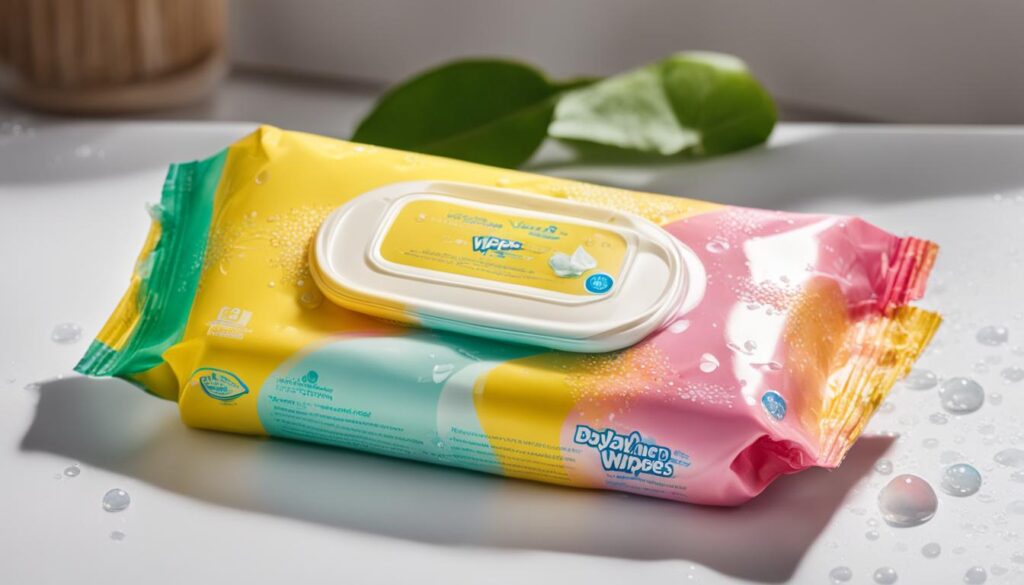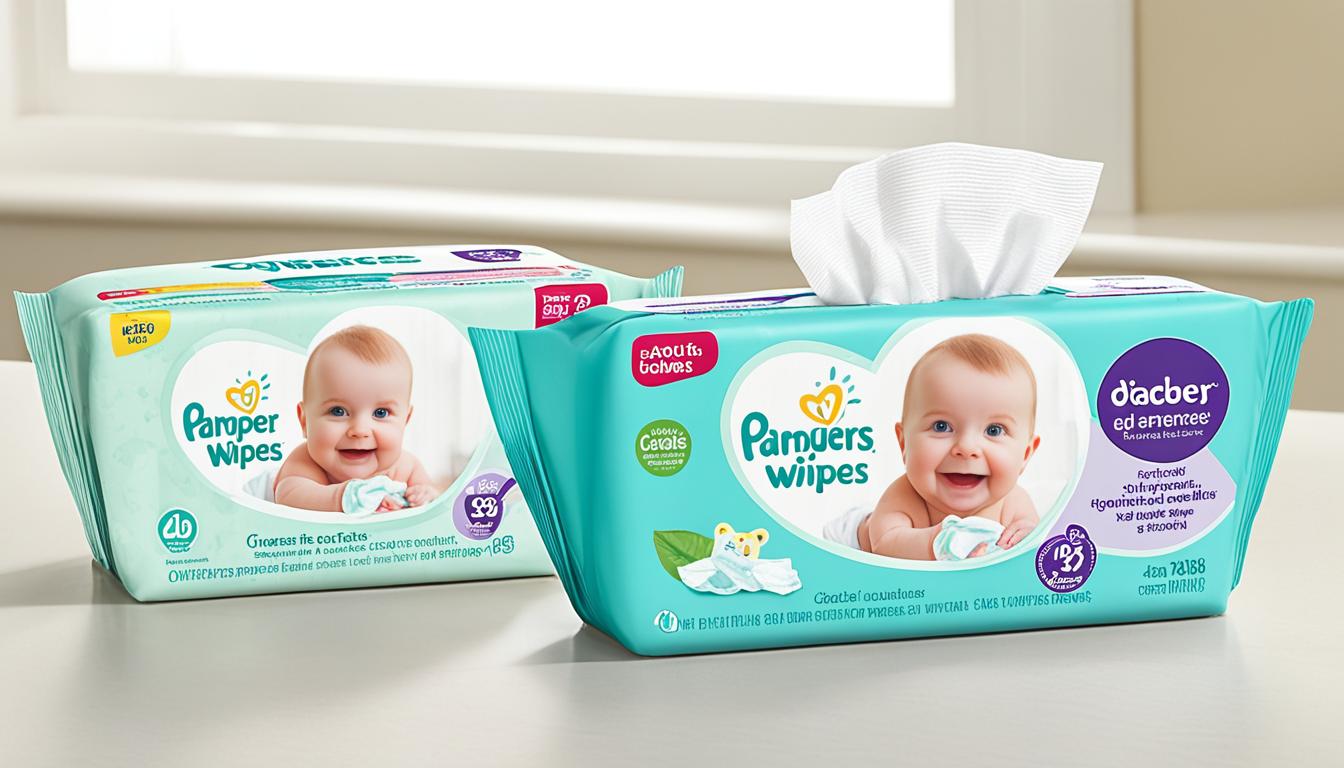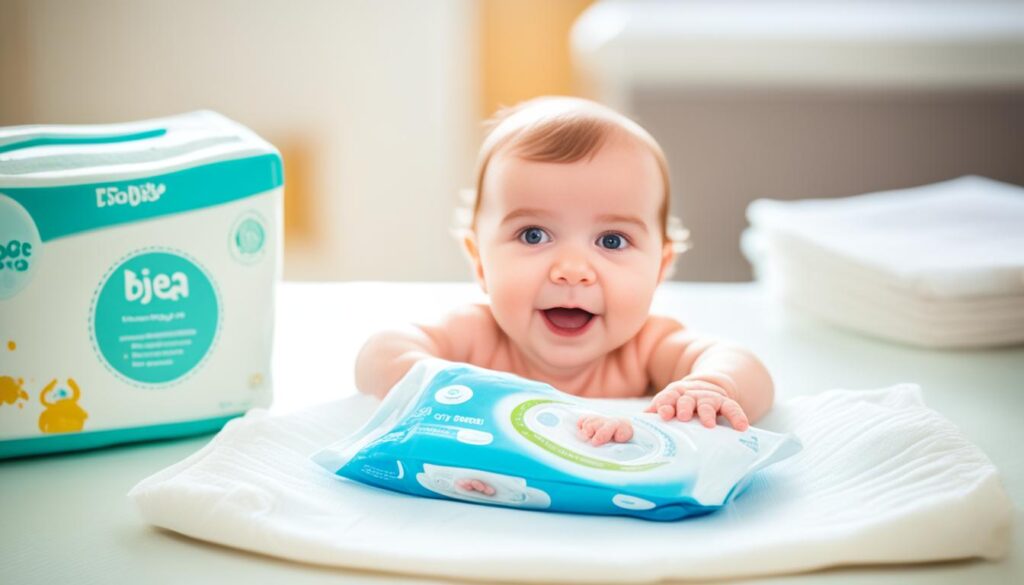When it comes to diaper changing, parents often wonder whether they should use wipes with every diaper change. Some may find it necessary for maintaining cleanliness and ensuring their baby’s comfort, while others may question its relevance for every diaper change. In this article, I will explore the benefits and considerations of using wipes with every diaper change, as well as provide some valuable diaper changing tips.
Key Takeaways:
- Using wipes with every diaper change helps maintain cleanliness and ensures your baby’s comfort.
- Wipes are particularly important for cleaning areas thoroughly and reducing the risk of diaper rash and infections.
- Consider using fragrance-free and hypoallergenic wipes that are suitable for your baby’s sensitive skin.
- Establishing a regular diaper changing routine helps prevent discomfort and keeps your baby happy and healthy.
- It’s important to monitor your baby’s cues for diaper changes and choose diapers that fit well to avoid leaks and discomfort.
How Often Should You Change a Baby’s Diaper?
When it comes to diaper changing, establishing a routine is essential for maintaining your baby’s comfort and hygiene. The frequency of diaper changes depends on how often your baby soils the diaper with urine and bowel movements. Here are some guidelines to help you determine how often to change your baby’s diaper.
Newborns
For newborns, diaper changes typically occur every two to three hours. Newborns have a small bladder and may urinate frequently, so it’s important to check their diapers regularly. Additionally, if your newborn has a bowel movement, it’s crucial to change the diaper right away to prevent potential skin irritations and discomfort.
Wet Diapers vs. Soiled Diapers
Wet diapers usually don’t require immediate changing unless your baby seems uncomfortable or the diaper is causing skin irritation. It’s important to use your judgment and check for any signs of discomfort. On the other hand, soiled diapers, especially those with feces, should be changed right away to maintain your baby’s hygiene and prevent the risk of infections.
Cloth Diapers
If you’re using cloth diapers, it’s recommended to change them more frequently, approximately every 90 minutes. Unlike disposable diapers, cloth diapers are less absorbent, so they require more frequent changing to prevent leaks and discomfort. Keeping a consistent cloth diaper changing routine is essential to maintain your baby’s comfort and prevent skin irritations.
Tracking Bowel Movements
To establish a regular diaper changing routine, it’s important to track your baby’s bowel movements. By recognizing patterns, you can anticipate when a diaper change is needed. Some babies have regular bowel movements after feeding, while others may have different patterns. Understanding your baby’s cues and rhythms will help you determine the optimal timing for diaper changes.
When it comes to choosing the best wipes for your baby, look for wipes that are gentle on the skin, fragrance-free, and suitable for sensitive skin. These wipes will help keep your baby’s bottom clean and fresh during diaper changes. Maintaining a consistent diaper changing routine and using high-quality wipes are essential for your baby’s comfort and overall well-being.
The Importance of Timely Diaper Changes
Delaying diaper changes can have negative consequences for your baby’s comfort and well-being. It can lead to diaper rash, skin chafing, infections, and an increased risk of leaking or diaper breakage. Additionally, your baby may end up touching the waste in their diaper, which can further contribute to discomfort and potential health issues.
One common consequence of delayed diaper changes is diaper rash. When urine or feces come into contact with your baby’s sensitive skin for an extended period, it can cause irritation and inflammation, leading to a painful rash. This can make your baby fussy and uncomfortable, making it harder for them to sleep or engage in daily activities.
Another issue that can arise from delaying diaper changes is skin chafing. When wetness and friction combine, it can create a perfect environment for chafing, which can cause redness, soreness, and discomfort for your little one.
Moreover, delayed diaper changes can also increase the likelihood of diaper breakage and leaking. Over time, the accumulated moisture can break down the diaper’s absorbency, compromising its effectiveness. This can result in leaks, creating messes that require extra cleaning and potentially contributing to skin irritation.
On top of all these concerns, waiting too long to change a diaper can lead to a worsening odor. The longer a diaper remains soiled, the stronger the odor can become. This can become unpleasant for both you and your baby, and it may require additional measures to eliminate the scent.
To prevent these issues and promote your baby’s overall well-being, it is crucial to establish a routine of regular and timely diaper changes. Aim to change your baby’s diaper as soon as you notice it is dirty or wet, and be attentive to their cues for diaper changes. Keeping a supply of clean diapers and baby wipes within easy reach can help facilitate quick and convenient diaper changes.
Regular and timely diaper changes are essential for keeping babies happy and healthy. By consistently attending to their diapering needs, you can prevent uncomfortable conditions like diaper rash, skin chafing, and diaper breakage, as well as manage any unpleasant odors.
Remember, your baby’s comfort and hygiene are a top priority, and implementing a proactive approach to diaper changes is key to maintaining their well-being.
Diaper Changes for Newborns
When it comes to diaper changes for newborns, it’s important to establish a routine that keeps your baby clean and comfortable. Newborns may require more frequent diaper changes, especially if they are breastfeeding. It is recommended to change your baby’s diaper every two to three hours to prevent discomfort and potential skin issues.
If your newborn has a bowel movement, it’s best to change the diaper right after a feeding. This timing ensures that you clean your baby thoroughly and minimize the risk of irritation. However, for wet diapers, you can use your judgment. Wet diapers may not require immediate changing, but if your baby seems uncomfortable or if it’s been a while since the last diaper change, it’s a good idea to change it.
Monitoring your baby’s cues for diaper changes is essential. Look for signs such as fussiness, squirming, or a dirty diaper indicator. By paying attention to your baby’s needs, you can ensure timely and efficient diaper changes, promoting their comfort and hygiene.
Diaper Changes for Newborns – Quick Tips:
- Change your newborn’s diaper every two to three hours.
- Diaper changes should occur right after a feeding if there is a bowel movement.
- Use your judgment for wet diapers, but it’s generally best to change them regularly throughout the day.
- Pay attention to your baby’s cues for diaper changes, such as fussiness or dirty diaper indicators.
Diaper Changes for Cloth Diapers
When it comes to cloth diapers, there are a few things to consider. Cloth diapers are known for being less absorbent than disposables, so they may require more frequent changing. In fact, it is recommended to change cloth diapers approximately every 90 minutes to ensure your baby stays dry and comfortable.
One of the downsides of using cloth diapers is the additional cleaning and maintenance they require. Unlike disposables, cloth diapers need to be washed and dried after each use. This may add extra work to your diaper changing routine, but many parents find it worth the effort.
Despite the extra time and effort, cloth diapers have their advantages. One of the main benefits is cost savings. By opting for cloth diapers, you can significantly reduce your monthly expenses on disposable diapers. Plus, cloth diapers are better for the environment as they generate less waste.
Before deciding on cloth diapers, it’s important to weigh the pros and cons. While they may require more frequent changing and additional cleaning, the cost savings and eco-friendly aspect make them a popular choice among many parents.
Overnight Diaper Changes
When it comes to diaper changes at night, parents often wonder if it’s necessary to wake their sleeping baby. The good news is, it’s generally okay to let your little one sleep through the night without changing diapers, especially if they are sound asleep. Wet diapers are generally okay and won’t disrupt your baby’s sleep. However, when it comes to dirty diapers with bowel movements, it’s important to change them promptly to avoid discomfort and potential diaper rash.
To ensure a more comfortable diapering experience for your baby at night, you can consider using nighttime diapers. These diapers are specially designed to be more absorbent, providing extra protection against leaks and keeping your baby dry throughout the night. Nighttime diapers are particularly helpful for heavy wetters or babies who sleep longer stretches.
To prevent diaper rash, you can apply a skin protective cream or ointment before putting your baby to sleep. This creates a barrier between your baby’s delicate skin and any moisture in the diaper, reducing the risk of irritation and diaper rash. Consult with your pediatrician to choose a suitable cream or ointment for your baby’s skin.
It’s important to note that while overnight diaper changes may be minimized, regular diaper changes should be done once your baby wakes up in the morning. This ensures that your baby stays clean, comfortable, and free from diaper-related discomfort throughout the day. By following these tips, you can help prevent diaper rash and promote your baby’s overall well-being during nighttime diaper changes.
Choosing the Right Diaper Brand and Wipes
When it comes to diapering your baby, every family has their own preferences and experiences. Choosing the right diaper brand and wipes is essential for your baby’s comfort and hygiene. Here are some tips to help you make the best choices:
Diaper Preferences
Diaper preferences can vary from family to family. It’s important to find diapers that fit well and provide the best protection against leaks and discomfort. Some parents prefer to use wipes for every diaper change, while others find it unnecessary for wet diapers. Ultimately, it depends on your personal preference and your baby’s needs.
Best Baby Wipes
When it comes to choosing the best baby wipes, there are a few factors to consider. Look for wipes that are thick and durable, as they will be more effective in cleaning your baby’s delicate skin. Fragrance-free wipes are recommended for babies with sensitive skin, as they are less likely to cause irritation or allergies. Take the time to read reviews and compare different brands to find the best option for your little one.
Choosing the Right Diaper Brand
With so many diaper brands available on the market, it can be overwhelming to make a decision. It’s important to choose a diaper brand that offers a good fit and reliable performance. Look for diapers that are designed to prevent leaks and keep your baby dry throughout the day and night. Reading reviews and talking to other parents can also help you make an informed choice.

“Choosing the right diaper brand and wipes can make a big difference in your baby’s comfort and your peace of mind. Don’t be afraid to try different options until you find the ones that work best for you and your little one.”
By taking the time to choose the right diaper brand and wipes, you can ensure that your baby stays comfortable, dry, and happy. Remember, every baby is unique, so it may take some trial and error to find what works best for you. Trust your instincts and go with what feels right for your family’s needs.
How Many Diapers and Wipes Does a Baby Use
When it comes to diaper usage, the number can vary from baby to baby. On average, babies go through six to ten diapers per day. However, during the first month, it is recommended to have up to 12 diapers per day to ensure you have an ample supply on hand. Cloth diapers, on the other hand, tend to require changing around 8 to 10 times per day.
Along with diapers, baby wipes are an essential part of every diaper change. The number of wipes used depends on the diaper changes. On average, you can expect to use around three to four wipes per dirty diaper change.
It’s important to remember that these numbers are just averages, and your baby’s diaper usage may vary. It’s always a good idea to have extra diapers and wipes on hand, just in case.
Providing your baby with a clean and comfortable diaper is essential for their health and well-being. By having an understanding of how many diapers and wipes to have on hand, you can ensure that you’re always prepared for diaper changes throughout the day.
Understanding Diaper Sizes and Fit
When it comes to diapering your baby, choosing the right size is essential for their comfort and protection. Diapers are available in various sizes, which are determined based on your baby’s weight. It’s crucial to select the appropriate size to ensure a proper fit and prevent leaks or discomfort.
- Diaper Sizing: Diapers are labeled with weight ranges to help you determine which size is suitable for your baby. The packaging usually includes a chart indicating the weight range for each diaper size. Be sure to follow this guide when selecting diapers.
- How to Know if a Diaper Fits: To check if a diaper fits correctly, it should sit just below the baby’s navel. There should be enough room for two fingers to slide around the waistband comfortably. This ensures that the diaper is snug but not too tight, allowing your baby to move freely.
- Checking the Leg Elastic: Another important aspect of a diaper’s fit is the leg elastic. Make sure the elastic is snug but not digging into your baby’s skin. This helps prevent leaks and provides a secure fit around the legs.
- Sizing Up if Needed: If you find that the diaper feels too tight or leaves marks on your baby’s skin, it may be time to size up. Babies grow quickly, and it’s normal for them to move up to the next diaper size as they gain weight.
Understanding diaper sizing and ensuring a proper fit is vital for your baby’s comfort and protection. Take the time to select the right size and regularly check if the diaper still fits as your baby grows. With the right diaper size, you can provide your little one with a comfortable and worry-free diapering experience.
Conclusion
In conclusion, proper diaper changing is essential for your baby’s comfort and hygiene. By following some simple tips, you can ensure a positive diapering experience for both you and your little one.
Firstly, make sure to observe your baby’s cues for diaper changes. This could include fussiness, a wet or soiled diaper, or a strong odor. By responding promptly to these cues, you can prevent discomfort and potential skin irritations.
Establishing a regular diaper changing routine is also important. This helps to maintain cleanliness and prevent any prolonged exposure to moisture or waste. Remember to change your baby’s diaper every two to three hours, or as needed.
Lastly, choosing the right diapers and wipes plays a significant role in your baby’s comfort and hygiene. Opt for diapers that fit well and do not cause leakage or discomfort. Additionally, select baby wipes that are gentle, fragrance-free, and suitable for sensitive skin.
By following these diaper changing tips and prioritizing your baby’s comfort and hygiene, you can create a pleasant and healthy environment for your little one.


